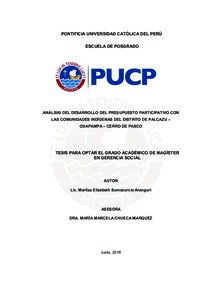| dc.contributor.advisor | Chueca Márquez, María Marcela | |
| dc.contributor.author | Somocurcio Aranguri, Maritza Elizabeth | es_ES |
| dc.date.accessioned | 2019-04-08T17:53:15Z | es_ES |
| dc.date.available | 2019-04-08T17:53:15Z | |
| dc.date.available | 2019-04-08T17:53:15Z | es_ES |
| dc.date.created | 2018 | es_ES |
| dc.date.issued | 2019-04-08 | es_ES |
| dc.identifier.uri | http://hdl.handle.net/20.500.12404/13916 | |
| dc.description.abstract | El presente estudio tiene como objetivo conocer y analizar el desarrollo
del Presupuesto Participativo del Distrito de Palcazu, la participación de
las Comunidades Indígenas en dicho proceso y la credibilidad del mismo.
Con dicho análisis se pretende proponer acciones que mejoren el
desarrollo del Presupuesto Participativo y la participación de las
Comunidades Indígenas en los procesos de Participación Ciudadana.
Asimismo, se contempla la revisión bibliográfica de diversos autores
acerca de Participación Ciudadana, Normativa Nacional e Internacional, y
Comunidades Indígenas. La metodología que se empleó fue de carácter
mixto, mediante un estudio de caso. Las unidades de análisis fueron los
jefes y comuneros de las Comunidades Indígenas, autoridades de las
organizaciones de base, autoridades del Municipio de Palcazu y
organizaciones distritales como el comité de concertación, asociaciones y
federaciones. Para el recojo de la información se han empleado
entrevistas semi-estructuradas y la revisión documental relacionados al
proceso de Presupuesto Participativo. Las entrevistas estuvieron dirigidas
a tres grupos: 1) A informantes claves de cuatro (04) comunidades
indígenas: líderes, jefes de las comunidades y miembros de la junta
directiva comunal; 2) a informantes claves del Gobierno Local de:
funcionarios y representantes del área de planificación; 3) a informantes
claves de otras instituciones no indígenas: miembros de la junta directivas
y presidentes. La aplicación de las entrevistas muestra cómo se desarrolló
el Presupuesto Participativo en el año 2009, cómo fue la participación de
las Comunidades Indígenas en el Proceso de Presupuesto Participativo,
cuál fue el medio más apropiado para informar y realizar las
convocatorias, la interacción entre Gobierno Local y las Comunidades
Indígenas, si existe o no una cultura de planificación y qué oportunidades
tuvieron las Comunidades Indígenas. Finalmente, se brindan
recomendaciones para superar dichas limitaciones y debilidades. | es_ES |
| dc.description.abstract | The objective of this investigation is to know the development of the
Participatory Budget of the District of Palcazu, the participation of the
Indigenous Communities in that process and its credibility. The purpose of
this analysis is to propose actions that improve the development of the
Participatory Budget and the participation of the Indigenous Communities
in the processes of Citizen Participation. Likewise, the bibliographic review
of various authors about Citizen Participation, National and International
Regulations, and Indigenous Communities is contemplated. The
methodology used was of a mix nature, through a case study. The units of
analysis were the chiefs and comuneros of the Indigenous Communities,
authorities of the people organizations, authorities of the Municipality of
Palcazu and district organizations such as the conciliation committee,
associations and federations. For the collection of information, semistructured
interviews and documentary review related to the Participatory
Budget process have been used. The interviews were directed to three
groups: 1) To key informants from four (04) indigenous communities:
leaders, heads of communities and members of the community board of
directors; 2) to key informants of the Local Government of: officials and
representatives of the planning area; 3) to key informants from other nonindigenous
institutions: board members and presidents. The application of
the interviews shows how the Participatory Budget was developed in
2009, how was the participation of the Indigenous Communities in the
Participatory Budget Process, what was the most appropriate means to
inform and make the calls, the interaction between Local Government and
the Indigenous Communities, if there is a culture of planning and what
opportunities did the Indigenous Communities have. Finally,
recommendations are given to overcome these limitations and
weaknesses. | es_ES |
| dc.description.uri | Tesis | es_ES |
| dc.language.iso | spa | es_ES |
| dc.publisher | Pontificia Universidad Católica del Perú | es_ES |
| dc.rights | info:eu-repo/semantics/openAccess | es_ES |
| dc.rights.uri | http://creativecommons.org/licenses/by/2.5/pe/ | * |
| dc.subject | Presupuesto municipal--Palcazu (Oxapampa : Distrito) | es_ES |
| dc.subject | Comunidades indígenas--Participación ciudadana | es_ES |
| dc.subject | Presupuesto--Perú--Cerro de Pasco | es_ES |
| dc.title | Análisis del desarrollo del presupuesto participativo con las comunidades indígenas del distrito de Palcazu - Oxapampa - Cerro de Pasco | es_ES |
| dc.type | info:eu-repo/semantics/masterThesis | es_ES |
| thesis.degree.name | Maestro en Gerencia Social | es_ES |
| thesis.degree.level | Maestría | es_ES |
| thesis.degree.grantor | Pontificia Universidad Católica del Perú. Escuela de Posgrado | es_ES |
| thesis.degree.discipline | Gerencia Social | es_ES |
| renati.discipline | 314127 | es_ES |
| renati.level | https://purl.org/pe-repo/renati/level#maestro | es_ES |
| renati.type | http://purl.org/pe-repo/renati/type#tesis | es_ES |
| dc.publisher.country | PE | es_ES |
| dc.subject.ocde | https://purl.org/pe-repo/ocde/ford#5.09.00 | es_ES |






